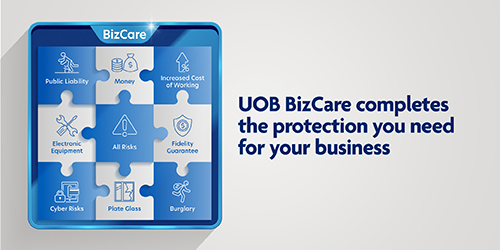You are now reading:
Managing Employee Retention and Growth
1 of 3



Starting or growing a business? Enjoy more than S$4,000 savings now with essential solutions. T&Cs apply.
Find out more
Your go-to sustainability guide. Get your customised report today by taking the quiz now.
Take the quizyou are in GROUP WHOLESALE BANKING


You are now reading:
Managing Employee Retention and Growth
The opening up of borders and restrictions has seen markets resume phased recovery. While the business climate remains challenging, businesses are expecting things to pick up. With more operations going digital, we see changes in the way businesses are run, and how people work.
The shift in work behaviours over the past two years has resulted in employees re-evaluating their work priorities to manage proper work-life balance, with some even considering leaving their current position. In the first half of 2022, close to 1 in 3 employees were looking to make a job switch. We also see that the top three factors influencing employees to move to other companies are work-life balance, salary and benefits, along with a conducive work environment.
With an understanding of how employees view work today, here are 3 ways you can rethink employment and retention as an employer:
89% of employers believed that financial incentives were the reason their employees left their company. In reality, only 1 in 10 employees switched their jobs for financial reasons. This points to a divergence between what employees want and what employers offer. Hence, the key to retaining your employees lies in your ability to identify what motivates your team and convinces them to stay.
60% of the companies in the Achievers Workforce Institute collected surveys from their employees to find ways to improve their employee working experience. However, only 34% of employees felt their employers had taken action after understanding their needs.
As an employer, perhaps you can create a core team whose responsibility is to care for the welfare of your employees. They can collate feedback from your employees and implement follow-up actions. The team may also consider improving the communication channels. For example, instead of using feedback forms, the team can organise regular engagement sessions to check in on your employees’ well-being.
According to the recent poll commissioned by Prudential Singapore, 9 in 10 employees said they wanted their employers to provide health coverage. Additionally, 40% of the respondents were more likely to stay in companies that provide medical benefits, and 60% of the respondents were more willing to join SMEs that provide medical benefits.
“Awareness of health and protection has gone up since the pandemic,” said Mr Dennis Tan, CEO of Prudential Singapore. “So understandably, employees value medical benefits and appreciate investments in their well-being and future.”
A recent survey by Mercer Marsh Benefits revealed that 55% of employees in Singapore experience everyday stress. Less than 44% of them also said they have access to mental health services, which is lower than the global and Asia average at 52% and 54% respectively. Hence, employers can show care for their employees by providing mental health benefits to alleviate the pressure experienced by their workers.
Employers may also choose to provide mental health support by establishing a caretaker group that regularly checks on employees’ mental health. It is also crucial to have the initiative from the ground to ensure that employees are engaged. Through these efforts, some companies have managed to keep their employees’ morale high throughout the pandemic.
With more employees valuing their health, an active attempt to ensure employee wellness shows that you care for your employees. This boosts their happiness and productivity, and reduces employee attrition.
The unexpected pandemic has accelerated the digitalisation of business processes. According to the 2021 ASEAN Digital Generation Report, 51 to 76% of micro, small, and medium enterprises want to undertake digital transformation. However, 43% of IT executives in the region face a shortage of tech talents to assist them in building digital solutions. Hence, it is crucial to reskill and upskill employees so that they are ready for wide-scale digital adoption
Based on the NTUC Learning Hub’s Employers Skill Survey 2021, employers in the region shared the same sentiment. From the report, we see that 57% of employers are looking to equip their employees with general technology skills, while 52% want to reskill their employees with technical skills beyond their current job scopes.
Beyond enabling digital transformation, there are other benefits of reskilling and upskilling your employees. Employers that invest in upskilling their employees will reap the benefits of increased revenue and productivity. Upskilling also allows career progression for your employees, which provides them with more reasons to stay in your company. Investment in manpower may sometimes be a risk for employers, but it is also a clear act of trust in employees — which many have come to appreciate.
There have been many avenues of support that fund training efforts, one of which is the Enhanced Training Support for SMEs (ETSS) by SSG. It provides up to 90% of subsidies to companies that sponsor employee training. Alternatively, applying for the SME Working Capital Loan can also help give you the cash flow you need to take your business and employees to the next level.
The past few years have seen significant changes in employees’ behaviour and priorities – some even take the definitive step to leave the workforce in pursuit of improved quality of life. Hence, it is paramount for employers to take active and intentional efforts to retain their talents. The best support that employers can provide for their employees goes beyond salaries and benefits, but a progressive shift toward empathy, engagement, and education.
The information contained in this publication is based on certain assumptions and analysis of publicly available information and reflects prevailing conditions as of the date of the publication. Any opinions, projections and other forward-looking statements regarding future events or performance of, including but not limited to, countries, markets or companies are not necessarily indicative of, and may differ from actual events or results.
The views expressed within this publication are solely those of the author’s and are independent of the actual trading positions of United Overseas Bank Limited, its subsidiaries, affiliates, directors, officers and employees (“UOB Group”). Views expressed reflect the author’s judgment as at the date of this publication and are subject to change.
UOB Group may have positions or other interests in, and may effect transactions in the securities/instruments mentioned in the publication. This publication is not an offer, recommendation, solicitation or advice to buy or sell any product or enter into any transaction and nothing in this publication constitutes accounting, legal, regulatory, tax, financial or other advice. Please consult your own professional advisors about the suitability of any transaction/ investment product/securities/ instruments for your investment objectives, financial situation and particular needs.
UOB Group may have also issued other reports, publications or documents expressing views which are different from those stated in this publication. Although every reasonable care has been taken to ensure the accuracy, completeness and objectivity of the information contained in this publication, UOB Group makes no representation or warranty, whether express or implied, as to its accuracy, completeness and objectivity and accept no responsibility or liability relating to any losses or damages howsoever suffered by any person arising from any reliance on the views expressed or information in this publication.
This publication has not been reviewed by the Monetary Authority of Singapore.

Start your UOB eBusiness account today, and enjoy zero fees* and more than S$500 of annual savings on FAST and GIRO transaction fees.

Get 10% off when you sign up for BizCare. Protect your business against business interruption with an SME-tailored plan.
T&Cs apply.

20 Nov 2025 • 5 mins read

12 Aug 2025 • 7 mins read

30 May 2025 • 3 mins read

29 Apr 2025 • 3 mins read